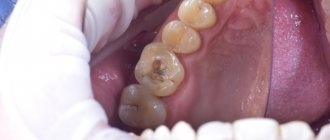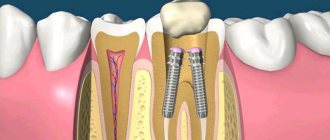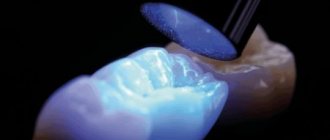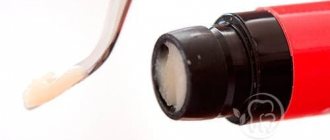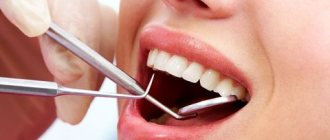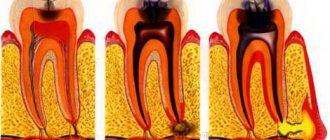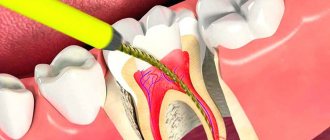Many patients do not know that they can put fillings on their front teeth. Its goal is not only to eliminate defects, but also to restore anatomical, physiological and aesthetic properties.
The procedure is quite popular. In order for the result to please the patient, it is necessary to choose a competent specialist with extensive experience. A professional will select the necessary material individually for each type of teeth and install the product so that it will not be noticeable in the smile area.
Installing a temporary filling
A filling between the front teeth is often placed due to carious lesions. For several days, it protects healthy tissues and nerve endings from external influences.
After a session of cleaning the canals and removing the nerve, the structure is replaced with a permanent one.
Life time
temporary product depends on the need for installation. As a rule, it is worn for no more than one month. Lasts about three days if arsenic is present.
When treating pulpitis or advanced stages of caries, the reaction of the unit is checked. Antibiotics are applied under the material. In this case, you need to walk for at least three weeks. The installation method is identical.
The following can be used as the main material:
- polycarboxylate cement,
- dentine,
- vinoxol,
- karyosan,
- softened paste
Alternative solutions
Dental fillings are widely used to restore the integrity of a tooth after removal of carious lesions. However, they cannot always be placed effectively, in particular in cases of large destruction of the coronal part and the absence of side walls of the tooth. In such situations, inlays (classic or stump, additionally placed inside the root canals) or crowns can be used.
1 Remizov, S. M. Micromechanical characteristics of restorative dental materials, enamel and dentin of human teeth. Dentistry, 2001.
Replacing a filling
Sometimes it becomes necessary to change fillings on the front teeth. Replacement is due if it is fixed:
- Violation of the integrity of the closure of the carious cavity. This process provokes infection.
- Vertical or horizontal shrinkage of material.
- Heavy load due to chewing. Because of this, destruction occurs.
- The development of periodontal tissue diseases - gingivitis, periodontitis.
- Overhang of the edges on the gum.
- Wear due to flat occlusal surface.
- Change in the shade of an artificial tooth (usually darkening).
- Poor quality of oral hygiene.
- Diastema of the frontal units.
- Changing the inclination.
- Insufficient cleaning of dental plaque in the area adjacent to adjacent molars.
Treatment of caries
Most often, a filling is necessary during the treatment of carious lesions of the hard tissues of the tooth. Interesting fact: caries occurs only in humans; no species of mammals has such dental problems. If necessary, it can be induced artificially, for example, in laboratory conditions in experimental rats. Caries is a kind of human payment for excessive consumption of sweets, flour and other harmful products.
After eating, food particles settle on the surface of the teeth, especially at the junction of the tooth and gum tissue, and bacteria and microbes begin to multiply. Dirt also accumulates in fissures - small grooves on the surface of the chewing teeth. It is these places that are considered the main places where caries appears.
As a result of the vital activity of bacteria, quite active organic acids appear, which negatively affect the health of tooth enamel. Destroyed enamel attracts even more bacteria, resulting in the production of even more acids. These processes are irreversible, so treatment of caries should begin as soon as possible. For this, a filling technique is used.
Painfulness of the procedure
Most people are afraid of the procedure precisely because of toothache, but modern technology and the use of anesthesia eliminate this ailment.
The session is completely painless. To reduce the likelihood of discomfort, all manipulations are carried out after the administration of an anesthetic. If there is no nerve, the procedure is performed without anesthesia. The patient may feel slight pressure on the gum.
An exception is intolerance to certain medications used for anesthesia. The choice is made in favor of a similar drug with a different active substance.
After the injection, no painful sensations are observed.
It hurts if there is a strong inflammatory process at the root apex and in the canals. Unpleasant sensations occur only when the drug gets into the periodontal tissues. They go away instantly after increasing the dosage of the painkiller.
Some pain is possible if there is a deep stage of carious lesions, depulpation or canal treatment is performed, or sensitivity is increased.
Doctors' recommendations after dental filling
Refusing food for a period of 2 hours or more is already a thing of the past. Modern dentistry makes it possible to consume food and drinks almost immediately after filling without strict restrictions.
The main recommendations after installing the filling are as follows:
- limit the consumption of highly colored foods for a couple of hours after the filling procedure;
- do not drink coffee or strong tea for an hour after the filling is installed;
- listen to your feelings - if within 24 hours after filling the pain does not go away, moreover, it increases, you need to urgently contact a dentist;
- If you feel that a tooth is interfering with your bite, you should also contact the dentist who performed the procedure.
Installation on the front teeth
The procedure takes from half an hour to an hour and a half, depending on the complexity of the problem.
The stages of setting up the frontal units are as follows:
- Carrying out professional oral hygiene. The hygienist cleans the molars and interdental space from plaque.
- Determination of tone.
- Introduction of anesthesia. The anesthetic is selected taking into account the patient's tolerance to the active substance. The injection is given in the gum area.
- Removal of caries. If the pathology affects only the superficial layers, then the disease is eliminated by grinding.
- Removal of the inflamed area of the pulp.
- Preparing the plane. The dentist treats the surface with a drill.
- Acid and adhesive treatment of dentin and enamel for better adhesion.
- Treatment with an antiseptic solution. This point is important in order to reduce the risk of microbial development.
- Application of material. It hardens quickly, so it is important to “shrink” it immediately with a special tool.
- Bite check. To do this, the doctor asks the patient to bite down on a plate of dye. When a certain area of this element is painted, a violation is considered.
Performing grinding and polishing of the artificial surface for proper bite and ideal smoothness.
When restoring the anterior dentition, diastema closure is often performed. This is possible if the spaces between the central molars are small. More material is applied to the incisors to increase their width. Thus, the distance between them disappears.
Types of fillings for front teeth
The design on the frontal incisors must have such properties as resistance to abrasion and destruction, biocompatibility, thermal conductivity to protect against exposure to different temperatures, and matching the enamel in structure and shade.
There are several types of materials. They have their own characteristics:
- Cement silicophosphate
(zinc phosphate or polycarboxylate) material. Among the advantages, it is worth highlighting the low cost. However, there are many more disadvantages: Firstly, fixation and adherence to the walls is insufficient. Secondly, the color is noticeably different, since the cement quickly acquires a yellowish tint. Thirdly, the surface of the artificially created unit is poorly polished. - Composite
The structure, shape and color of a natural incisor are most clearly conveyed. It is characterized by increased strength. The downside is the risk of roughness if the material is not mixed well. - Plastic.
Its advantages include a tight fit, aesthetic component and mechanical strength of the material. The color palette is wide and you can easily choose a shade to match the color of your teeth. The negative aspects are that the plastic darkens and turns yellow, the surface gradually becomes rough, acrylic releases toxins and also shrinks.
When choosing, you need to know how long different types of fillings last. Cement is short-lived. Their service life does not exceed one and a half years. Plastic products last up to three years. Good composite fillings last up to five years.
Types of filling materials
| Material type | Varieties | Description |
| Cement | – Zinc phosphate – Silicate – Glass ionomer | Currently, of all types of cement fillings, only glass ionomer fillings are actively used, since they provide good mechanical and chemical bonding with tooth tissues. Zinc-phosphate fillings tend to shrink, so they are almost never used when filling teeth for caries. Silicate materials are considered toxic and also have restrictions in their use. |
| Metal | – Gold – Copper – Silver | They are distinguished by high quality and a very large margin of safety. On the other hand, amalgam fillings shrink over time and are not always airtight, which can lead to the development of secondary caries. Due to low aesthetic indicators, they are used for filling chewing teeth. |
| Composite materials | – Acrylic – Epoxy – Light-curing – Chemical-curing | Composite fillings are obtained by mixing organic and inorganic elements. Due to the noticeable disadvantages of filling teeth with composite materials (rapid wear and toxicity for acrylic ones, fragility for epoxy ones), the first two types of fillings are practically not used. Light-curing composites are considered the best: they quickly harden under the influence of ultraviolet radiation and can be used in any part of the jaw. The procedure is often called light dental filling. |
| Compomer | It is a kind of hybrid of glass ionomer and composite | Very aesthetic and high-quality fillings, which are most often used in the frontal region when restoring teeth after chips. Their only drawback is fragility. |
| Materials for temporary fillings | – Artificial dentin – Soft dentin paste – Cariosan (cement) – Vinoxol (zinc oxide based) | They are often placed during pulpitis to check the reaction of the tooth, as well as after filling root canals until a permanent filling is installed. Temporary fillings are also used when filling a tooth under a crown. |
The best choice of fillings for front teeth
The filling must close the cavity and prevent infection of the canals. In the case of front teeth, the aesthetic aspect comes to the fore, so the material must have the appropriate properties.
The most durable fillings for damaged front teeth are light products
. They are made from a material that hardens under ultraviolet rays. The composition contains heliocomposite, glass-ceramic filler, and resin.
Durability of photopolymers
Photopolymers are characterized by increased strength. They can last up to 10 years. They are resistant to temperature, restore length and shape.
Reflective filling has many advantages
:
- Eating food and water is allowed immediately.
- Increased adhesive ability.
- Plastic. The material allows you to clean out any pores and cracks.
- Layer-by-layer application. Due to this, the grip is enhanced.
- The percentage of shrinkage is minimal compared to chemical analogues.
- Does not release toxins.
- Possibility of fixing in a small area.
- Possibility of choosing a color that is similar to enamel.
Minus
is high cost. As a result of the use of a UV lamp, the price does not allow the use of a light filling as a temporary structure.
A dental filling fell out: why?
There are several reasons why a filling falls out earlier (less than 2-4 years after installation):
- Violation of the clinical protocol for filling a tooth by a doctor.
- An incorrect bite that was not taken into account by the dentist when filling the tooth.
- Bruxism, in which there is a constant reflexive clenching of the jaws and grinding of teeth, which leads to “crushing the filling.”
- Violation by the patient of recommendations given after completion of medical work.
- Bad habits (biting nails, threads and wires with teeth, opening beer bottles and caps with teeth, etc.).
Yellowing of fillings on front teeth
Patients often experience discoloration of artificial units.
Causes
Common causes of pathology are:
- Getting injured.
- Secondary caries.
- Drinking black tea or coffee.
- Smoking.
Darkening is possible when the nerve is removed.
Correction methods
The first step is to carry out the whitening procedure. You can get rid of yellowing only with photopolymers. Only if the structure has lightened slightly does it need to be replaced.
Whitening methods
Photopolymers are bleached using the in-channel method. A special gel is injected into the root canal and a temporary structure is placed. After 2-3 procedures, the shade becomes lighter, and the structure is replaced with a permanent one.
Restoring teeth using root veneers
In orthopedics, there are unique possibilities for restoring teeth in cases where only one root remains of a tooth. You must immediately understand that the root tissue of the teeth must be healthy - this is the main condition for 100% tooth restoration. Look at the photo to see what we are talking about - caries-affected tissues are removed and ground down to healthy tooth tissues:
In such cases, veneers with the root part
:
And this is how beautifully, and most importantly, you can reliably restore your teeth:
Patients who encounter such technologies for the first time experience a wow effect, and their smile is not only restored, but becomes incredibly beautiful:
By the way, this clinical example can be viewed in more detail HERE
Lost filling on a front tooth
Causes
The reason for material loss may be:
- Neglect of oral hygiene and, as a result, plaque formation.
- Untimely removal of tartar.
- Inflammation of the pulp.
- Mechanical injuries.
- Chewing food with frontal incisors.
- Poor tooth preparation before the procedure.
- Eating seeds, nuts, etc.
- Excessive load on the front units. For example, opening lids, chewing threads, etc.
Elimination methods
With high-quality elimination of carious cavities, correction is carried out within a month. If the product was placed in the treatment of deep caries, then you should immediately contact the dentist to exclude an infectious process.
Treatment is prescribed depending on the cause of the loss. If there is repeated caries or loss of a pulpless tooth, re-installation does not make sense. The doctor suggests installing a pin or crown.
What to do if a piece of the filling breaks off
In this case, you should immediately visit a dentist
. The doctor will correct the problem in one visit if no spread of secondary caries is noticed.
If the chip occurs from the edge, then the restoration is carried out with the same material that was originally used. If a significant part has broken off, the doctor suggests changing the material or performing a complete restoration and extension.
Features of dental filling
Filling is the process of filling a cavity in a tooth that has formed due to caries. This type of service is considered one of the most popular among adult patients and children, since, unfortunately, caries occurs in almost all people. You can brush your teeth every day, rinse, use dental floss, and eat right, but it is impossible to insure yourself against caries. The only way out is to regularly visit the dentist’s office, who will pay attention to carious lesions in time and place a filling. Modern fillings make it possible to restore more than half of the destroyed crown enamel, while visually this tooth will not be any different from the whole natural one.
Dentistry "32 Dent" specializes in dental treatment for adult patients and children in Moscow. Only a competent approach, high-quality filling materials, treatment without pain and stress with a guarantee of results.
The filling on the front teeth interferes after treatment
In some cases, the design on the frontal incisors prevents the mouth from closing completely; the roughness injures the tongue or the mucous membrane of the lips.
Causes
Trouble arises if sufficient grinding and grinding of the excess surface has not been carried out.
Much less commonly, the cause is an excess of applied material when correcting the interdental gap on the front teeth.
The rarest situation occurs when the wall between the filling and the pulp chamber is thinned. There is a feeling of discomfort that irritates the nerve.
Complications
Ignoring pathology can lead to unpleasant consequences. For example:
- The high position of the artificial structure causes a lot of pressure on the jaw. Pulpitis and periodontitis gradually develop.
- Increases the likelihood of chipping.
- Uneven closing of the jaw contributes to its dislocation and other diseases of the temporomandibular apparatus.
What happens if the patient does not get a filling on time?
There is a high risk of developing diseases such as pulpitis, periodontitis (inflammation of the gums), as well as cystic formations on the roots.
In addition to tooth decay, inflammation of the temporomandibular joint may occur, which may lead to the need for surgical intervention.
For a patient, untreated caries is always a source of inflammation. For a person, this is fraught with weakened immunity and cases where the inflammatory process worsens at the most inopportune moment.
It will be much cheaper to identify caries in a timely manner and put a filling on the tooth, the price of which is about three thousand rubles, than to spend tens of thousands on installing a new tooth.
